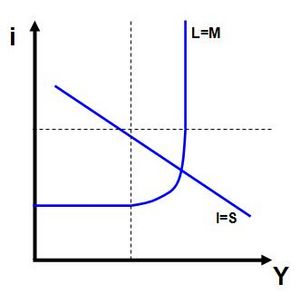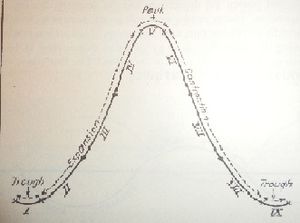Alvin Hansen facts for kids
Quick facts for kids
Alvin Hansen
|
|
|---|---|
| Born | August 23, 1887 |
| Died | June 6, 1975 (aged 87) |
| Nationality | Danish-American |
| Institution | Harvard University |
| Field | Macroeconomics, political economics |
| School or tradition |
Neo-Keynesian economics |
| Alma mater | University of Wisconsin–Madison Yankton College |
| Influences | John Maynard Keynes |
| Contributions | IS–LM model (Hicks–Hansen synthesis) Secular stagnation theory |
| Scientific career | |
| Thesis | Cycles of prosperity and depression in the United States, Great Britain and Germany; a study of monthly data 1902-1908 (1918) |
| Doctoral advisor | Richard T. Ely John R. Commons Frederic L. Paxson |
| Doctoral students | Evsey Domar Eva Mueller Hyman Minsky Richard Musgrave Lloyd Metzler |
Alvin Harvey Hansen (born August 23, 1887 – died June 6, 1975) was an important American economist. He taught at the University of Minnesota and later became a professor at Harvard University. People often called him "the American Keynes" because he helped bring Keynes's ideas to the United States.
Hansen wrote many popular books about economic issues. He was also a key advisor to the government on economic policy. He helped create important parts of the U.S. economy, like the Council of Economic Advisers and the Social Security system. He is best known for making Keynesian economics popular in the U.S. during the 1930s and 1940s.
He worked with John Hicks to create the IS–LM model. This model is a way to show how Keynesian economic ideas work using math. In 1967, Paul McCracken, who led the President's Council of Economic Advisers, said that Hansen had influenced the nation's economic thinking more than any other economist in that century.
Contents
Alvin Hansen's Early Life and Education
Alvin Hansen was born in Viborg, South Dakota on August 23, 1887. His father, Niels Hansen, was a farmer. Alvin graduated from Yankton College in 1910, where he studied English.
In 1913, he went to the University of Wisconsin–Madison to study economics. There, he learned from teachers like Richard T. Ely and John R. Commons. They taught him how to use economics to solve important social problems. He finished his studies for a PhD in 1916. Hansen married Mabel Lewis, and they had two children.
Alvin Hansen's Career in Academia
Hansen taught at Brown University while he was writing his PhD paper, which was called "Cycles of Prosperity and Depression." After he finished it in 1918, he moved to the University of Minnesota in 1919. He quickly became a full professor there by 1923.
His books, Business Cycle Theory (1927) and Principles of Economics (1928), made him well-known among economists. In 1932, he wrote Economic Stabilization in an Unbalanced World. This book helped him become known in public affairs.
In 1937, Hansen was invited to teach at Harvard University. His first book at Harvard, Full Recovery or Stagnation? (1938), talked about his idea of "secular stagnation." This idea suggested that the economy might not grow much without help.
He also wrote America's Role in the World Economy (1945) and Economic Policy and Full Employment (1947). These books shared his ideas with a wider audience. From 1940 to 1945, Hansen worked as a special economic advisor to the Federal Reserve Board.
After he stopped teaching in 1956, he continued to write. His later books included The American Economy (1957) and The Dollar and the International Monetary System (1965). He passed away in Alexandria, Virginia, on June 6, 1975, at 87 years old.
Alvin Hansen's Economic Ideas
Alvin Hansen made several important contributions to how we understand economics.
The IS–LM Model
One of his most famous contributions was developing the IS–LM model with John Hicks. This model is also called the "Hicks–Hansen synthesis." It uses a diagram to show how different parts of the economy connect.
- The IS curve shows the relationship between investment and saving.
- The LM curve shows the relationship between how much money people want (liquidity preference) and the money supply.
This model helps economists understand how government spending (fiscal policy) and central bank actions (monetary policy) can affect a country's total income or GDP. It is still used in many economics textbooks today.
Keynesian Economics
When John Maynard Keynes first published his book The General Theory of Employment, Interest and Money, Hansen was a bit doubtful. However, by 1938, he fully supported Keynes's ideas. Keynes believed that governments needed to step in during economic downturns.
After Hansen arrived at Harvard in 1937, his special class on fiscal policy became very popular. He inspired many students, including Paul Samuelson and James Tobin, who later won the Economics Nobel. These students helped to further develop and spread Keynesian economics.
Hansen's 1941 book, Fiscal Policy and Business Cycles, was the first major book in the U.S. to fully support Keynes's ideas. It explained why the Great Depression happened. Hansen used this explanation to argue that the government should spend more money, even if it meant creating a deficit.
Secular Stagnation Theory
In the late 1930s, Hansen suggested that the American economy was facing "secular stagnation." This idea meant that the economy might not grow quickly again. He thought that important growth factors, like new technology and population growth, were slowing down.
Hansen believed the only way to fix this was for the government to spend a lot of money constantly. This idea was very controversial. Critics called Hansen a "pessimist." However, the strong economic growth that started in 1940 made his stagnation model less popular.
Economic Cycles
Alvin Hansen also made important contributions to the study of economic cycles. In his book Business Cycles and National Income, he explained that economic cycles are changes in jobs, production, and prices.
He divided a cycle into two parts:
- Expansion: When the economy grows, from its lowest point to its highest.
- Contraction: When the economy shrinks, from its highest point to its lowest.
Hansen believed that economic cycles could be stable or unstable. He thought that outside events, like new technologies or changes in money markets, could make cycles unstable.
Alvin Hansen's Public Policy Work
During the Great Depression, Hansen argued that the U.S. economy was not just in a bad business cycle. He thought it was losing its long-term ability to grow. He suggested that the government should not just spend money to stabilize jobs. Instead, he wanted big projects like:
- Bringing electricity to rural areas.
- Cleaning up poor neighborhoods.
- Developing natural resources.
He believed these projects would create new opportunities for private businesses. This would help the whole economic system become strong again.
Hansen taught and influenced many students who later worked in government. He also served on many government committees dealing with economic issues. The American Economic Association gave him a special award, the Walker Medal, in 1967.
Hansen often spoke to the U.S. Congress. He argued against using unemployment to control inflation. He believed that inflation could be managed by changing tax rates and the money supply. He also supported controlling prices and wages. He pushed for government spending and other actions to prevent the stagnation he thought was common in developed economies.
During the presidencies of Franklin D. Roosevelt and Harry S. Truman, Hansen worked on government commissions. He was also a consultant for the Federal Reserve Board and the United States Department of the Treasury. In 1935, he helped create the U.S. Social Security system. In 1946, he helped write the Full Employment Act, which created the Council of Economic Advisers.
During World War II, Hansen strongly supported Keynesian policies. He wanted to ensure there would be full employment after the war. His efforts helped convince Keynes to work on plans for the international economy.
See also
 In Spanish: Alvin Hansen para niños
In Spanish: Alvin Hansen para niños
Images for kids





